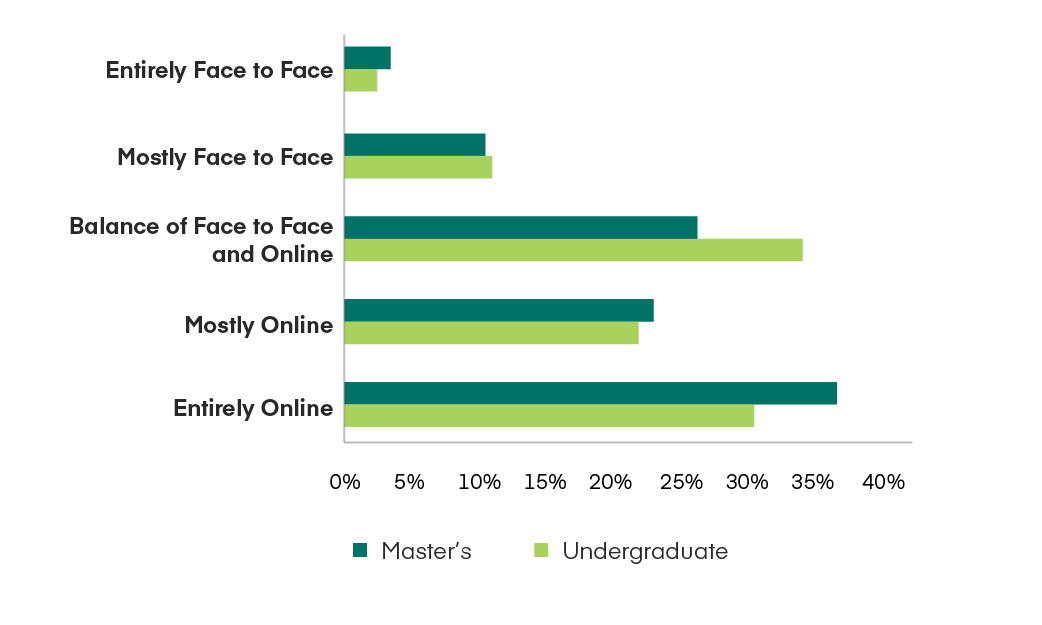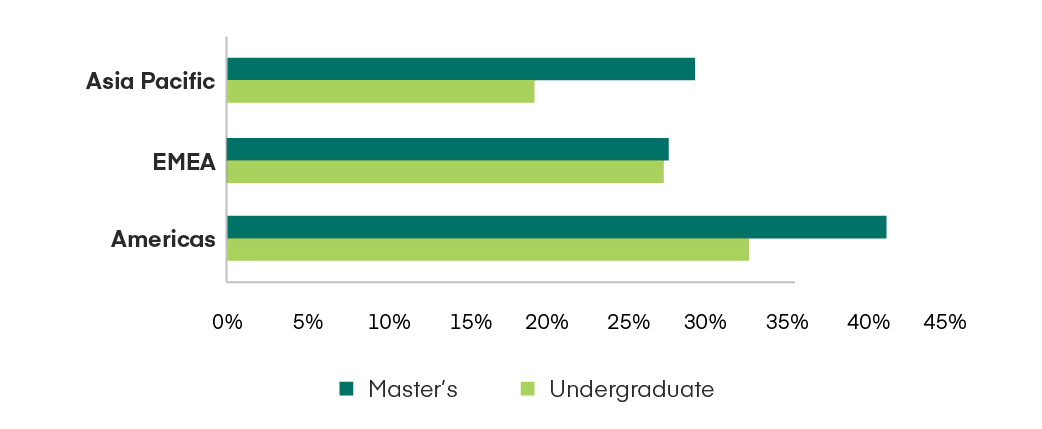AACSB Quick-Take Survey on COVID-19: Business School Enrollment Impacts
Since the outbreak of the pandemic, many business education leaders have been predicting the impact COVID-19 will have on our industry. In an AACSB survey conducted in May, business educators were widely preparing to deliver their programming virtually, with 87 percent of respondents indicating that they were preparing to offer a mix of virtual and in-person learning. With many business schools’ fall terms having begun by mid-September, we are now able to look at how these schools delivered their learning experiences, and what the relative impact was on their enrollment.
A survey conducted in mid-October asked the heads of business schools to report, for their most recent terms starting from July through September, their school’s method of delivery for courses, how their enrollment had changed from the same term in the prior year, as well as their balance of international and domestic enrollment. A total of 316 institutions participated in this quick-take survey, representing 52 countries (186 in the Americas; 84 in Europe, the Middle East, and Africa (EMEA); and 46 in Asia Pacific).
Delivery Method
We found that, while many schools were preparing for hybrid program delivery when asked in May, quite a few schools ultimately decided to administer their coursework entirely online. In May, only 11 percent of schools surveyed were preparing to deliver their courses entirely online. But for these most recent term beginnings, 31 percent of undergraduate and 37 percent of master's courses that were delivered face-to-face pre-pandemic are now being delivered entirely online.
That said, in the recent survey most schools did end up delivering their coursework with some degree of both online and face-to-face elements: 87 percent of undergraduate courses and 86 percent of master’s courses that were delivered primarily face to face last year are now being delivered at least partially online.
Chart 1. Delivery method by degree level of courses typically offered face to face last year

This chart details shifts from courses that were primarily offered face to face pre-COVID, showing that only a small percentage remained face to face a year later, with the majority shifting to some reliance on online delivery.
Looking at schools that opted to deliver their courses entirely online, schools in the Americas did so at highest rate for master’s programs (41 percent), nearly doubling the rate for master's courses in EMEA (27 percent). It is worth noting that the United States schools comprised most of the respondents for the Americas (with 167 out of 186 total responses in this region). For undergraduate courses, schools in EMEA and the Americas (at 29 percent and 33 percent respectively) delivered entirely online education more often than in Asia Pacific (20 percent).
Chart 2. Percentage of typically face-to-face courses now delivered entirely online, by region

While mostly or entirely face-to-face educational delivery was not quite as common, it was reported at a higher percentage for Asia Pacific undergraduate programs (40 percent of total) and Asia Pacific master’s programs (36 percent of total).
Enrollment Change
In May, we asked schools to predict how their enrollment would change across all program levels for their upcoming term, and 46 percent of responding schools expected a decrease. Only 13 percent of schools believed they would see an enrollment increase.
The results from our October survey show that business schools have largely exceeded those enrollment expectations, with 82 percent of undergraduate programs and 77 percent of master's programs experiencing either an increase or no change from the prior year.
Chart 3. Percentage change in enrollment from prior year

Looking at undergraduate programs specifically, we found the greatest percentage of schools reporting an enrollment increase are in EMEA. Eighty-two percent of undergraduate programs in EMEA reported an increase (of any amount) in enrollment, as opposed to 65 percent in the Americas and 71 percent in Asia Pacific. Though many schools reported increases in enrollment, these increases were fairly small. Across all regions, 53 percent of reported increases were between 1 and 4 percent, and 65 percent were between 1 and 19 percent.
For master’s program enrollment, 43 percent of schools reported an increase of less than 10 percent or about the same. But there was a greater percentage of schools that reported significant gains for master’s program enrollment than undergraduate program enrollment. For 34 percent of schools, the master’s program enrollment increase was greater than 9 percent, and at 22 percent of schools, the increase was greater than 20 percent.
Overall, the enrollment turnouts have been encouraging. Compared to earlier forecasts of how business schools would fare in attracting students, the survey results show a more positive picture.
In 2008, with uncertain job markets in many countries due to the recession, business schools performed well in terms of enrollment, with many learners opting to pursue a business education to upskill and help ensure their ability to be hired, or delaying entrance into the workforce until the job market became more certain. Similar responses may be occurring with COVID, as businesses freeze hiring due to uncertain conditions, sending prospective employees back to school. The increase in availability of online education may also have increased access for some students to gain a business degree, when geographic constraints may have previously kept the pursuit out of reach.
In a future article, we will examine the impact that international travel and recruitment may have had on these enrollment changes.
